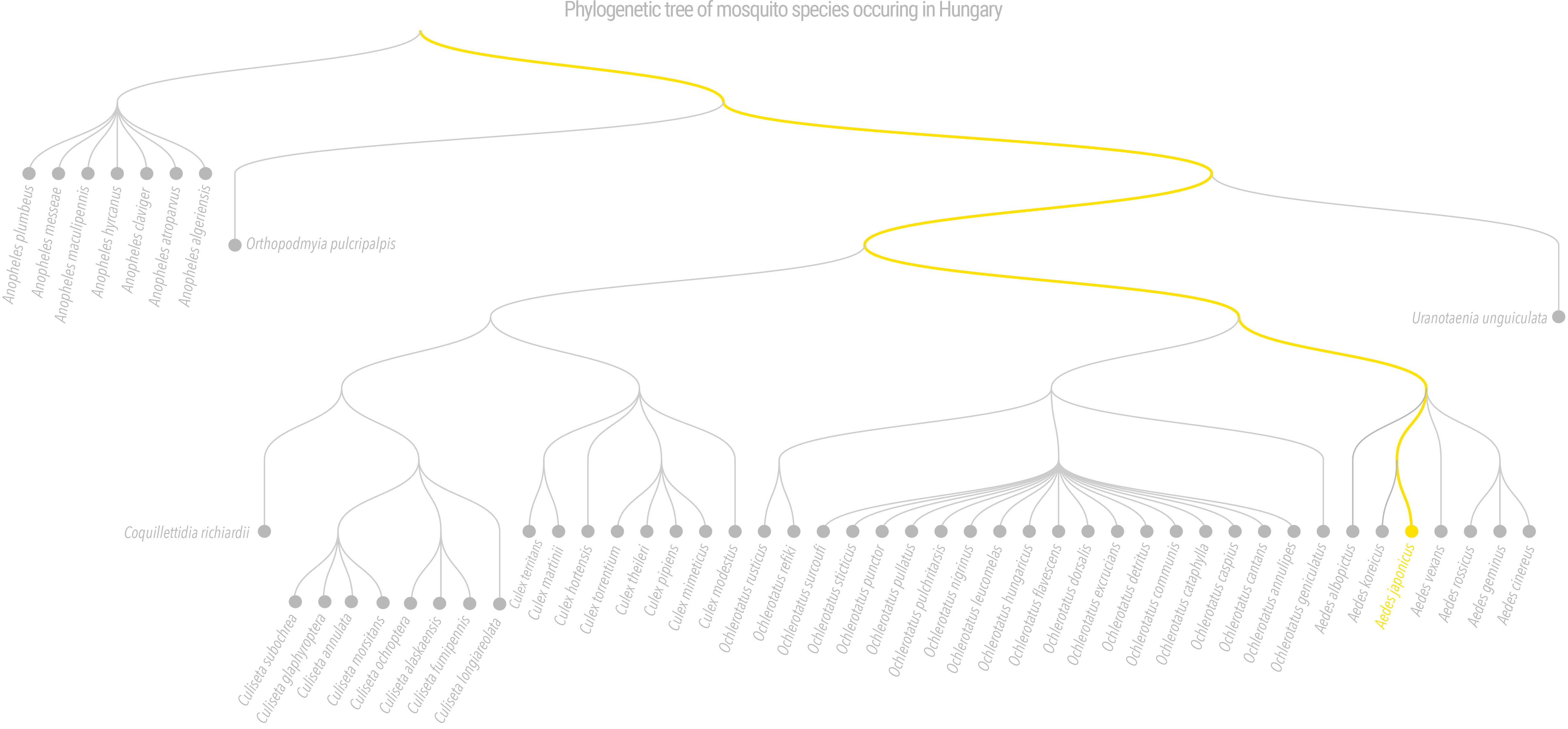ASIAN BUSH MOSQUITO
ASIAN
BUSH MOSQUITO
AEDES JAPONICUS
MORPHOLOGY
The adult (imago) Asian bush mosquito is bigger than the tiger mosquito and the Korean mosquito: its body length is ca. 6 mm. They are black with patterns formed by light and darker brown scales. It can be distinguish from the other invasive species by its coloration, since it is lighter and of lower contrast compared to the tiger mosquito. The eggs are half-millimeter long, black colored and cigar-shaped, larvae have a brownish yellow color.

ORIGIN AND DISTRIBUTION RANGE
Like invasive mosquitoes in general, the emergence of the Asian bush mosquito in Europe and the quick expansion of its distribution range was also assisted by globalization and international trade and tourism. In Europe, it appeared for the first time in 2000, when it was detected in Normandy,in northwestern France. Further dispersal of the species was facilitated by transport of used tires. In 2002 it was observed in Belgium, later in 2008 a national mosquito monitoring program revealed the presence of both larvae and adult specimens in the country. In the same year, it emerged in Switzerland and Germany as well, and shortly after that, it was detected in further European countries as well: Austria, Slovenia, Croatia, and Spain. In Hungary, the Asian bush mosquito was first reported in 2012 near the Slovenian border and spreads mainly on the western part of the country. In 2017 and 2018 it was collected in large quantities near the lake Balaton, today it is widespread in the country.
ECOLOGY
The eggs of the Asian bush mosquito are extremely resistant, they survive freezing temperatures and drought. This ability enables it to emerge anywhere as soon as the weather gets good enough. However they are limited by extremely hot temperatures: above 30°C they can’t develop, which can restrain their spreading in the future. They overwinter as eggs in their native habitat in Japan and Europe as well. The freeze and desiccation-resistant eggs can survive unfavorable conditions for years and hatch once environmental conditions become favorable again, i.e. when they are covered by stagnant water and the temperature is right, they begin to develop. Larvae can be found in both natural and artificial water bodies which can be as small as few liters or less to serve as ideal breeding sites. In their natural habitat, they usually develop in tree holes and rock pools, but they thrive in urban areas as well: tires, bird baths, vases placed on graves, rainwater containers, barrels, watering cans, buckets or milk boxes are suitable for the development of the larvae. The larvae begin to filter-feed immediately after hatching, their food consists of particulate organic matter, bacteria, and unicellular eukaryotes. The biting adults of Asian bush mosquito are active until late autumn in its native range, and it has many generations through the year. In Europe its season of activity begins in May and can last until October, its reproduction can decline in the hottest months of summer, being more abundant in early summer or early autumn. Adults are active during the day and at sunset, and aggressively attack humans even indoor, but they feeds on other mammals as well.
TRANSMISSION OF PATHOGENS
The Asian bush mosquito is responsible for the North-American West Nile virus epidemic, the most notable disease transmitted by this species. Laboratory studies have also shown that it is a competent vector of Japanese encephalitis virus, Chikungunya virus, Yellow fever, and Dengue virus as well.
HOW TO DISTINGUISH IT FROM OTHER INVASIVE SPECIES?
Its black-colored body bears lighter and darker brown scales. On the dorsal side of the thorax, there are five golden stripes, the two parallel ones on the middle are longer and clearly visible.. Similar to the other two invasive species, the legs are black with white rings, however, the third legs’ last segment is completely black with no white ring.
The dorsal pattern on the thorax formed by golden scales can be confused with the Korean mosquito, but the middle two stripes are thicker and longer (while the tiger mosquito has only one bright white line on the thorax). Another difference is revealed by observing the last tarsomere of the third legs: it does not bear a white ring-like patch characteristic of the Korean mosquito.